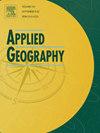调查城市交通事故的诱因:新型堆叠式综合学习框架
IF 4
2区 地球科学
Q1 GEOGRAPHY
引用次数: 0
摘要
事故诱因识别在预防事故和为决策过程提供信息方面起着至关重要的作用。然而,目前的方法严重依赖于技术专家的主观判断,忽视了全面、科学的分析。为了弥补这一不足,我们提出了一个研究框架,利用堆叠集成学习来预测碰撞风险水平并识别碰撞诱因。该框架首先利用 ArcGIS 构建自适应缓冲区并获取多源数据(即街景数据、POI 数据、碰撞数据)。然后,我们将四个单一模型(如 RF、SVM、XGBoost、NBC)整合为基础模型,并将它们在训练数据上的预测结果视为新的特征集。然后,我们以真实标签作为监督信号来训练元模型,从而将各模型的结果融合到元模型中。通过性能比较确定最有效的模型,并从结果中得出碰撞诱因在空间尺度上的平均相对重要性(MRI)。研究结果表明,在所有导致碰撞的因素排名中,POI 的 MRI 最高,为 5.99%,其次是道路标志标线(1.98%)。这些结果有助于提高交通系统的性能,并提前干预危险区域,减少交通事故的发生。本文章由计算机程序翻译,如有差异,请以英文原文为准。
Investigating the contributing factors of urban crash levels: A novel stacking integrated learning framework
Crash contributing factors identification plays crucial role in preventing crashes and informing decision-making processes. However, current methods heavily rely on subjective judgments by technical experts, neglecting a comprehensive and scientific analysis. To address this gap, we propose a research framework that utilizes stacking integrated learning to predict crash risk levels and identify crash contributing factors. This framework first utilizes ArcGIS to construct adaptive buffers and obtain multi-source data (i. e., street view data, POI data, crash data). Then we integrate four single models (e.g., RF, SVM, XGBoost, NBC) as the base models, and treat their prediction results on the training data as a new feature set. We then train a meta model with the true labels as the supervision signal, thereby fusing the results of models into the meta model. The most effective model is determined through performance comparison, and the mean relative importance (MRI) of crash contributing factors on a spatial scale is derived from the results. The research results indicate that POIs have the highest MRI of 5.99% among all crash contributing factors ranking, followed by road signage markings (1.98%). These results contribute to enhancing transportation system performance, and intervening in hazardous areas in advance to reduce the occurrence of crashes.
求助全文
通过发布文献求助,成功后即可免费获取论文全文。
去求助
来源期刊

Applied Geography
GEOGRAPHY-
CiteScore
8.00
自引率
2.00%
发文量
134
期刊介绍:
Applied Geography is a journal devoted to the publication of research which utilizes geographic approaches (human, physical, nature-society and GIScience) to resolve human problems that have a spatial dimension. These problems may be related to the assessment, management and allocation of the world physical and/or human resources. The underlying rationale of the journal is that only through a clear understanding of the relevant societal, physical, and coupled natural-humans systems can we resolve such problems. Papers are invited on any theme involving the application of geographical theory and methodology in the resolution of human problems.
 求助内容:
求助内容: 应助结果提醒方式:
应助结果提醒方式:


